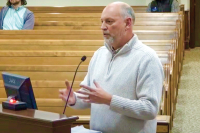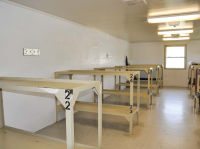Below ‘the line,’ it’s a world unto itself
 I spent a week reading this novel, and each time I laid it down, I expected to find a damp spot under it when I picked it up again. Rivers is about rain — unrelenting, unforgiving rain. This novel begins, “It had been raining for weeks. Maybe months. He had forgotten the last day that it hadn’t rained.” The world seemed to be dissolving around Cohen. Even the lumber that he used in his futile attempts to build an addition to his house became spongy and fell away as though rejecting its own nature. Even the land had become shifting mud and flowed away.
I spent a week reading this novel, and each time I laid it down, I expected to find a damp spot under it when I picked it up again. Rivers is about rain — unrelenting, unforgiving rain. This novel begins, “It had been raining for weeks. Maybe months. He had forgotten the last day that it hadn’t rained.” The world seemed to be dissolving around Cohen. Even the lumber that he used in his futile attempts to build an addition to his house became spongy and fell away as though rejecting its own nature. Even the land had become shifting mud and flowed away.
Although the critics characterize Rivers as “post apocalyptic,” the work seems to require classification as a new genre, possibly “environmental catastrophe.” The nightmarish setting is a coastal region that runs south of Hattiesburg, Mississippi, and Baton Rouge, Louisiana, — a 90-mile wide strip that has become so devastated by constant rain and storms in the years following Hurricane Katrina that the government has drawn a figurative and literal boundary called “the line” and declared all land below that boundary as “abandoned.” This action was followed by a massive evacuation.
Cohen, the protagonist of this tale, lost Elisa, his pregnant wife, in a tragic accident during this exodus and ended up returning to his farm to bury her. As time passes, he grieves for Elisa while he is learning to survive in a “barter and swap” world without electricity.
On one of his search for supplies, Cohen is robbed by two drifters and left for dead. Cohen manages to survive a harrowing trip through a landscape filled with feral animals and a night in an abandoned church. At home, he finds this house has been ransacked and his cherished belongings (letters and photos of Elisa) stolen. His resentment at being robbed grows and he sets out to find the people who stole his Jeep, his rifle and his belongings ... and his past. Sensing that the thieves may return, he leaves them a note: “He is not dead. He is risen.” Thirty minutes after Cohen rides away on his horse, Habana, the thieves return and find his note.
Eventually, Cohen’s search leads him into a bizarre community consisting of a half-dozen locked FEMA trailers containing a group of pregnant women and ruled by a snake-handling minister named Aggie and two young men. Aggie shoots Cohen in the leg and then attempts to convince him to join Aggie’s “commune.” Aggie dreams of founding a new world that he rules like a biblical prophet ... a world created by the children of the pregnant women.
Eventually, Cohen assumes the role of savior. In the process, he delivers a baby (at the cost of the mother’s life) and kills Aggie. The liberated women torch the camp and, under Cohen’s leadership, load two trucks and launch a desperate journey to “the line” and a world with medical supplies and electricity.
Related Items
Cohen has a new companion: Mariposa, the “woman from New Orleans” who was one of the robbers who had tried to kill him. As the two trucks wander from abandoned town to abandoned town where bands of thieves and mercenaries control vital supplies (gasoline, water, canned food, etc.), the world this band of wanderers encounters resembles that of Cormac McCarthy’s The Road. At times, the suspense and tension has much in common with “The Walking Dead” series. The world seems full of abandoned homes and a chance encounter with other people may promise refuge or threat. Indeed, when the group finally reaches “the line,” it seems to be vague and shifting. Then there are the men with the black raincoats: are they government agents? If so, do they have their “own agenda”?
During the latter half of this novel, the reader will discover that Cohen has a secret. For example, his obsession with his Jeep. When he is forced to abandon it during one encounter, he is distraught and talks a great deal about going on a life-threatening journey to reclaim it. He tells Mariposa that he left pictures of his dead wife in the Jeep and she is supportive of his plans to turn back ... drive south instead of north. Then, slowly the pieces come together. Throughout this trek through abandoned villages, Cohen has been mindful of a recurring image, fields filled with excavations that had been dug with a backhoe.
Although there were numerous reasons why some men refused to leave the abandoned land below the line, one of the major ones had to do with a widely circulated tale about the casinos that sprung up on the coast. It was a well-known fact that the casinos were the first to leave, leaving behind those ornate structures that would be trashed and swept away by the storms that now came with regularity. But what about the money? What about the awesome sums of money that the casino owners were reluctant to take above the line where government agencies would demand an accounting. The rumor that swept through the bars and hotels was about the fact that the money never left. It was buried ... possibly near the sites of the casinos.
So, men like Charlie, who was an old friend of Cohen’s family … Charlie bought a backhoe. For two years Charlie had endured both ridicule and attempts on his life. Charlie, like Aggie, had a dream. Somewhere out there was the casino money. Now, let me end this review with a single sentence that might be provocative: Cohen knows where the money is.
How would Charlie feel when he learns that Cohen has known this for two years?
In addition, I would like to make some critical observations on Rivers. This novel is saturated with dreams. If you squeeze this novel, the dreams drip out. Cohen’s dream of living a wildly romantic life with Elisa; Charlie’s dream of finding a buried treasure; Aggie’s dream of governing a tribe of pregnant women. Behind it all, it the recurring (literal) dream that Cohen has about Venice, a city built on water, a place he visited with Elisa and the conversation that he had with her about Thomas Mann’s novel, Death in Venice, and an old man’s hopeless obsession with a “perfect beauty” ... one that is forever beyond his grasp.
In a recent interview, Michael Farris Smith said that he had intended to tell a story about an ordinary fellow (Cohen) who would have preferred to have spent his life playing baseball, fishing and driving his truck, but circumstances forced him into a world where he reluctantly performed deeds that would normally have been beyond his capabilities. He becomes courageous ... even heroic. That is what Smith intended to do. I think he did it.









